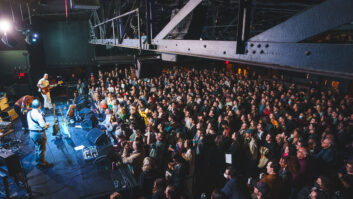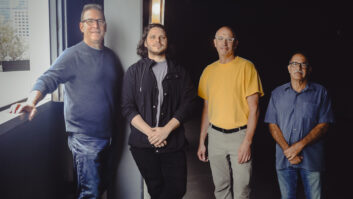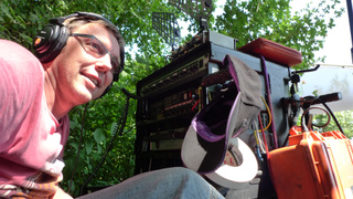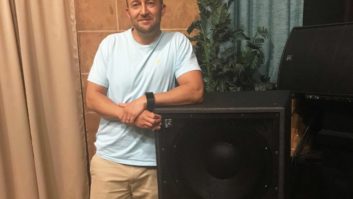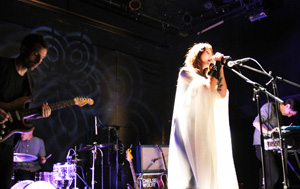
Chelsea Wolfe ignited the Bowery Ballroom in September 2013
Photo: Todd Berkowitz
The Bowery Ballroom has been open in Manhattan’s Lower East Side for the past 15 years. Operating under the aegis of Northeastern concert-promotion and venue management company The Bowery Presents, and with a capacity of 550, The Bowery Ballroom is selling out shows every week, presenting up-and-coming indie rock bands alongside the likes of Arcade Fire, The Pixies and Yoko Ono. In July, the readers of Rolling Stone magazine named the Bowery Ballroom one of the 10 best live music venues in the U.S., citing its “consistently great sound and sight lines.”
Production manager and front-of-house engineer Kenny Lienhardt has worked at The Bowery since the day it opened, mixing about four headlining acts and most opening acts each week. “I started as the only monitor guy for two years or so, and inherited the PM job about 12 years ago,” Lienhardt says. “I’m the only staff FOH guy, with an occasional sub from the crew. I mix about four headliners and most openers each week. The reason the Bowery sounds consistently great is a combination of things—some planned, some ‘happy accidents.’ I feel the main reason for the good sound is [our] analog equipment and full-range P.A. bins, versus digital consoles and line arrays, and the particular room treatments we employ, [which we] first used at Mercury Lounge, our first club.

Kenny Lienhardt, the Bowery Ballroom’s production manager and front-of-house engineer, at the venue’s Midas Heritage 3000 console.
Photo: Todd Berkowitz
“The high balcony and 25-foot-wide stage in a 35-foot-wide room guarantee even coverage and great sight lines,” Lienhardt says. “The [room] treatments eliminate any standing waves, and to a great degree, [the need for] any bass traps. The P.A. also has plenty of Crown [Audio] power to provide lots of headroom and great coverage straight to the back evenly. The wood floor also ensures the subs will transmit a ‘thump’ to every pair of feet in the house, even when its packed. Concrete won’t do that.”

Chelsea Wolfe ignited the Bowery Ballroom in September 2013
Photo: Todd Berkowitz
The Bowery uses EAW KF650z three-way, full range speakers, with a center cluster of KF695z’s to cover the 25-foot gap between main L/R speakers. “The system was designed by the late Matthew Kasha, with help from Jim Falconer and EAW,” Lienhardt says. “[It was] expertly done by a studio stalwart right down to the TT patchbay that connects our 15 comps, 10 gates and effects units. The [FOH] console is a Midas Heritage 3000, which replaced a Clair Bros. modified Yamaha PM3000 that served us well for 12 years. This rig will sound great with digital consoles as well, mostly due to the full range boxes and the fact that they are up in the corners of the room where they couple and create power.
“When the band gets loud, the room gets loud, not just the P.A..” Lienhardt continues. “The amazing EQ on the Midas means I very rarely employ the house graphic EQ. It’s just completely ‘studio like’ in there, with even a minimum of bodies. It must be mentioned that no soundcheck ends without the band saying to the monitor guy, ‘Sounds great up here!'”

Chelsea Wolfe’s drummer, Dylan Fujioka
Photo: Todd Berkowitz
Bowery Ballroom’s monitor rig comprises EAW SM260iV 2-way full range floor monitors, EAW Z29i’s and EAW SM500iV 2-way full range floor monitor with an 18-inch subwoofer for drums, all powered by Crown Macro-Tech Series amplifiers through a Soundcraft Spirit Monitor 2 analog mixer. “[It’s a] very good passive rig, and I changed the original board for the same model after 10 years,” Lienhardt adds, “a great uncolored console that gives plenty of clean output.
“Of course, the hanging of the entire rig is the reason for the great sight lines,” Lienhardt says. “It’s also up high and aimed down at the crowd. The rig is ‘bi-level,’ with a set of [EAW] 650s and three 695s hitting the full room and balcony area, and three 650s across the bottom set that covers the floor, L/C/R. The center box is pulled back to cover the first three rows in front, as well. Graphic EQs from Klark Teknik provide separate level/EQ control over three zones: main L/R, triple cluster on top, and a single 650 for the front row. Coverage is Job One! The high balcony and 25-foot wide stage in a 35-foot wide room guarantee even coverage and great sight lines. The full range boxes in the corners move the air, like a home stereo, and make everyone feel like they are in row 1 at MSG! The headroom gives us the possibility of uniform coverage.”
